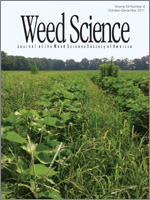Weed control in lentil is difficult because lentil is a poor competitor with weeds and few POST broadleaf herbicides are available. Imadazolinone-tolerant lentils have more herbicide options, but the optimum timing for herbicide application is not known. The critical period of weed control (CPWC) is the period in a crop's life cycle when weeds must be controlled in order to prevent yield loss. The objective of this research was to determine the CPWC for lentil. We made lentil remain weedy or weed-free from 0 to 11 aboveground nodes to investigate the durations of weed interference and weed-free period, respectively. It was found that lentil has a CPWC beginning at the five-node stage and continuing to the 10-node stage. There was an inverse relationship between weed biomass and lentil yield; that is, lentil yield was highest when weed biomass is minimal. We propose that the CPWC begins when weeds start to accumulate significant biomass and ends with crop canopy closure. Therefore, to maximize lentil yields, growers should consider using a POST residual herbicide that can control weeds during the CPWC.
Nomenclature: Lentil, Lens culinaris L. ‘CDC Impact’.





